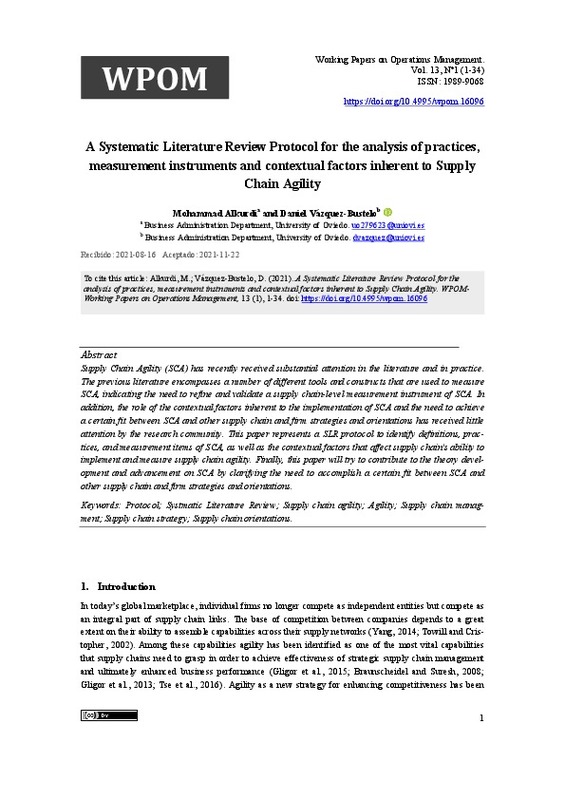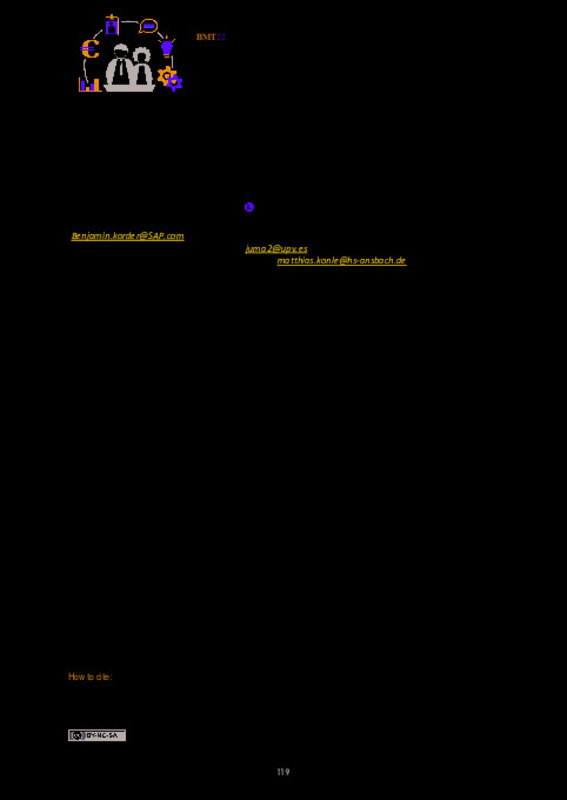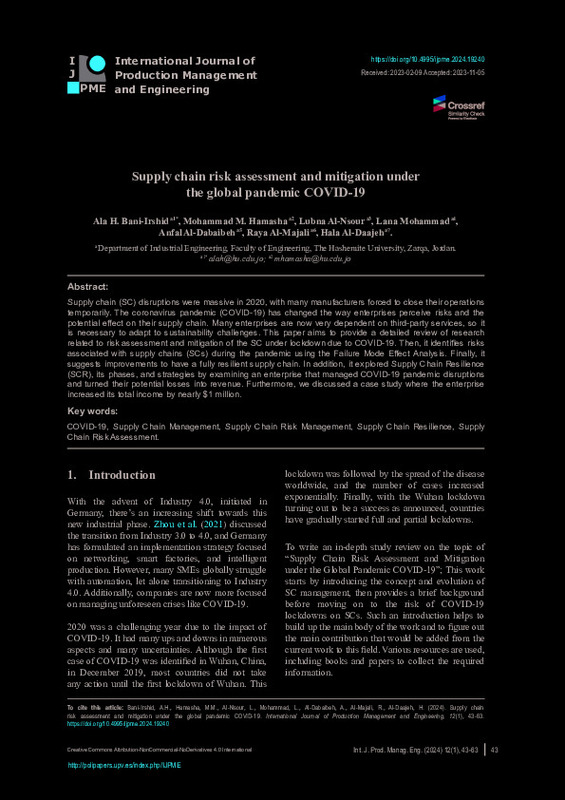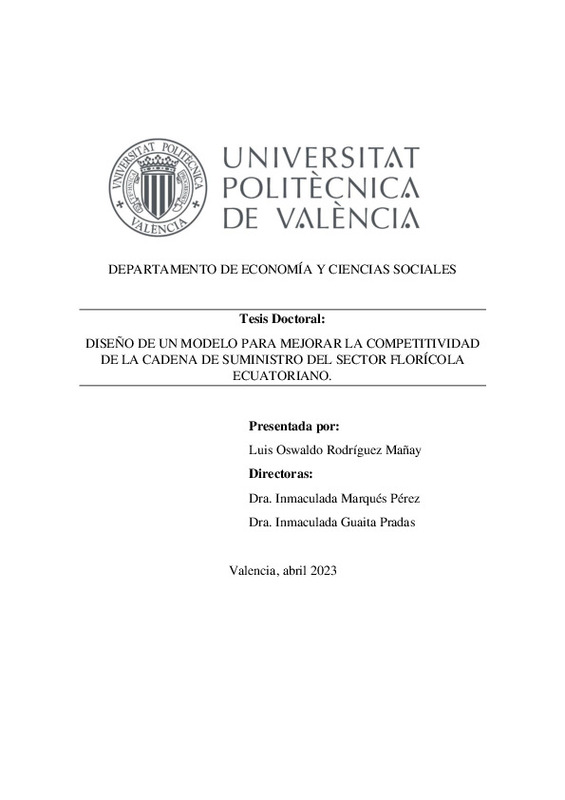JavaScript is disabled for your browser. Some features of this site may not work without it.
Buscar en RiuNet
Listar
Mi cuenta
Estadísticas
Ayuda RiuNet
Admin. UPV
A Systematic Literature Review Protocol for the analysis of practices, measurement instruments and contextual factors inherent to Supply Chain Agility
Mostrar el registro sencillo del ítem
Ficheros en el ítem
| dc.contributor.author | Alkurdi, Mohammad Hamza
|
es_ES |
| dc.contributor.author | Vázquez-Bustelo, Daniel
|
es_ES |
| dc.date.accessioned | 2022-01-31T07:50:46Z | |
| dc.date.available | 2022-01-31T07:50:46Z | |
| dc.date.issued | 2021-12-21 | |
| dc.identifier.uri | http://hdl.handle.net/10251/180381 | |
| dc.description.abstract | [EN] Supply Chain Agility (SCA) has recently received substantial attention in the literature and in practice. The previous literature encompasses a number of different tools and constructs that are used to measure SCA, indicating the need to refine and validate a supply chain-level measurement instrument of SCA. In addition, the role of the contextual factors inherent to the implementation of SCA and the need to achieve a certain fit between SCA and other supply chain and firm strategies and orientations has received little attention by the research community. This paper represents a SLR protocol to identify definitions, practices, and measurement items of SCA, as well as the contextual factors that affect supply chain's ability to implement and measure supply chain agility. Finally, this paper will try to contribute to the theory development and advancement on SCA by clarifying the need to accomplish a certain fit between SCA and other supply chain and firm strategies and orientations. | es_ES |
| dc.language | Inglés | es_ES |
| dc.publisher | Universitat Politècnica de València | es_ES |
| dc.relation.ispartof | WPOM-Working Papers on Operations Management | es_ES |
| dc.rights | Reconocimiento (by) | es_ES |
| dc.subject | Protocol | es_ES |
| dc.subject | Systmatic Literature Review | es_ES |
| dc.subject | Supply chain agility | es_ES |
| dc.subject | Agility | es_ES |
| dc.subject | Supply chain managment | es_ES |
| dc.subject | Supply chain strategy | es_ES |
| dc.subject | Supply chain orientations | es_ES |
| dc.title | A Systematic Literature Review Protocol for the analysis of practices, measurement instruments and contextual factors inherent to Supply Chain Agility | es_ES |
| dc.type | Artículo | es_ES |
| dc.identifier.doi | 10.4995/wpom.16096 | |
| dc.rights.accessRights | Abierto | es_ES |
| dc.description.bibliographicCitation | Alkurdi, MH.; Vázquez-Bustelo, D. (2021). A Systematic Literature Review Protocol for the analysis of practices, measurement instruments and contextual factors inherent to Supply Chain Agility. WPOM-Working Papers on Operations Management. 13(1):1-34. https://doi.org/10.4995/wpom.16096 | es_ES |
| dc.description.accrualMethod | OJS | es_ES |
| dc.relation.publisherversion | https://doi.org/10.4995/wpom.16096 | es_ES |
| dc.description.upvformatpinicio | 1 | es_ES |
| dc.description.upvformatpfin | 34 | es_ES |
| dc.type.version | info:eu-repo/semantics/publishedVersion | es_ES |
| dc.description.volume | 13 | es_ES |
| dc.description.issue | 1 | es_ES |
| dc.identifier.eissn | 1989-9068 | |
| dc.relation.pasarela | OJS\16096 | es_ES |
| dc.description.references | Abdallah, A. B., & Nabass, I. H. (2018). Supply chain antecedents of agile manufacturing in a develop-ing country context. Journal of Manufacturing Technology Management, 29(6), 1042-1064. https://doi.org/10.1108/JMTM-01-2018-0019 | es_ES |
| dc.description.references | Abdelilah, B., Korchi, A. E., & Balambo, M. A. (2018). Flexibility and agility: evolution and relation-ship. Journal of Manufacturing Technology Management, 29(7), 1138-1162. https://doi.org/10.1108/JMTM-03-2018-0090 | es_ES |
| dc.description.references | Agarwal, A., Shankar, R., & Tiwari, M. (2007). Modeling agility of supply chain. Industrial Marketing Management, 36(4), 443-457. https://doi.org/10.1016/j.indmarman.2005.12.004 | es_ES |
| dc.description.references | Alfalla-Luque, R., Machuca, J. A. D., & Marin-Garcia, J. A. (2018). Triple-a and competitive advantage in supply chains: Empirical research in developed countries. International Journal of Production Economics, 203, 48-61. https://doi.org/10.1016/j.ijpe.2018.05.020 | es_ES |
| dc.description.references | Altay, N., Gunasekaran, A., Dubey, R., & Childe, S. J. (2018). Agility and resilience as antecedents of supply chain performance under moderating effects of organizational culture within the humanitarian setting: a dynamic capability view. Production Planning & Control, 29(14), 1158-1174. https://doi.org/10.1080/09537287.2018.1542174 | es_ES |
| dc.description.references | Aslam, H., Blome, C., Roscoe, S., & Azhar, T. M. (2018). Dynamic supply chain capabilities How market sensing, supply chain agility and adaptability affect supply chain ambidexterity. Interna-tional Journal of Operations & Production Management, 38(12), 2266-2285. https://doi.org/10.1108/IJOPM-09-2017-0555 | es_ES |
| dc.description.references | Avelar-Sosa, L., García-Alcaraz, J., Mejía-Muñoz, J., Maldonado-Macías, A., & Hernández, G. (2018). Government Support and Market Proximity: Exploring Their Relationship with Supply Chain Agil-ity and Financial performance. Sustainability, 10(7), 2441. https://doi.org/10.3390/su10072441 | es_ES |
| dc.description.references | Baramichai, M., Jr., E. W., & Marangos, C. (2007). Agile supply chain transformation matrix: a QFD-based tool for improving enterprise agility. International Journal of Value Chain Management, 1(3), 281. https://doi.org/10.1504/IJVCM.2007.013305 | es_ES |
| dc.description.references | Bidhandi, R. A., & Valmohammadi, C. (2017). Effects of supply chain agility on profitability. Business Process Management Journal, 23(5), 1064-1082. https://doi.org/10.1108/BPMJ-05-2016-0089 | es_ES |
| dc.description.references | Blome, C., Schoenherr, T., & Rexhausen, D. (2013). Antecedents and enablers of supply chain agility and its effect on performance: a dynamic capabilities perspective. International Journal of Produc-tion Research, 51(4), 1295-1318. https://doi.org/10.1080/00207543.2012.728011 | es_ES |
| dc.description.references | Braunscheidel, M. J., & Suresh, N. C. (2008). The organizational antecedents of a firm's supply chain agility for risk mitigation and response. Journal of Operations Management, 27(2), 119-140. https://doi.org/10.1016/j.jom.2008.09.006 | es_ES |
| dc.description.references | Brusset, X. (2016). Does supply chain visibility enhance agility? International Journal of Production Economics, 171, 46-59. https://doi.org/10.1016/j.ijpe.2015.10.005 | es_ES |
| dc.description.references | Carvalho, A. M., Sampaio, P., Rebentisch, E., Carvalho, J. Á., & Saraiva, P. (2017). Operational excel-lence, organisational culture and agility: the missing link? Total Quality Management & Business Excellence, 30(13-14), 1495-1514. https://doi.org/10.1080/14783363.2017.1374833 | es_ES |
| dc.description.references | Chan, A. T., Ngai, E. W., & Moon, K. K. (2017). The effects of strategic and manufacturing flexibilities and supply chain agility on firm performance in the fashion industry. European Journal of Opera-tional Research, 259(2), 486-499. https://doi.org/10.1016/j.ejor.2016.11.006 | es_ES |
| dc.description.references | Chen, C.-J. (2019). Developing a model for supply chain agility and innovativeness to enhance firms' competitive advantage. Management Decision, 57(7), 1511-1534. https://doi.org/10.1108/MD-12-2017-1236 | es_ES |
| dc.description.references | Degroote, S. E., & Marx, T. G. (2013). The impact of IT on supply chain agility and firm performance: An empirical investigation. International Journal of Information Management, 33(6), 909-916. https://doi.org/10.1016/j.ijinfomgt.2013.09.001 | es_ES |
| dc.description.references | Dhaigude, A., & Kapoor, R. (2017). The mediation role of supply chain agility on supply chain orienta-tion-supply chain performance link. Journal of Decision Systems, 26(3), 275-293. https://doi.org/10.1080/12460125.2017.1351862 | es_ES |
| dc.description.references | Du, Y., Hu, X., & Vakil, K. (2021). Systematic literature review on the supply chain agility for manu-facturer and consumer. International Journal of Consumer Studies, 45(4), 581-616. https://doi.org/10.1111/ijcs.12645 | es_ES |
| dc.description.references | Dubey, R., Gunasekaran, A., & Childe, S. J. (2019). Big data analytics capability in supply chain agili-ty. Management Decision, 57(8), 2092-2112. https://doi.org/10.1108/MD-01-2018-0119 | es_ES |
| dc.description.references | Durach, C. F., Kembro, J., & Wieland, A. (2017). A New Paradigm for Systematic Literature Reviews in Supply Chain Management. Journal of Supply Chain Management, 53(4), 67-85. https://doi.org/10.1111/jscm.12145 | es_ES |
| dc.description.references | Eckstein, D., Goellner, M., Blome, C., & Henke, M. (2014). The performance impact of supply chain agility and supply chain adaptability: the moderating effect of product complexity. International Journal of Production Research, 53(10), 3028-3046. https://doi.org/10.1080/00207543.2014.970707 | es_ES |
| dc.description.references | Faisal, M. N., Banwet, D. K., & Shankar, R. (2007). An approach to measure supply chain agility. International Journal of Industrial and Systems Engineering, 2(1), 79. https://doi.org/10.1504/IJISE.2007.011438 | es_ES |
| dc.description.references | Fayezi, S., Zutshi, A., & Oloughlin, A. (2016). Understanding and Development of Supply Chain Agil-ity and Flexibility: A Structured Literature Review. International Journal of Management Reviews, 19(4), 379-407. https://doi.org/10.1111/ijmr.12096 | es_ES |
| dc.description.references | Feizabadi, J., Maloni, M., & Gligor, D. (2019). Benchmarking the triple-A supply chain: orchestrating agility, adaptability, and alignment. Benchmarking: An International Journal, 26(1), 271-295. https://doi.org/10.1108/BIJ-03-2018-0059 | es_ES |
| dc.description.references | Geyi, D. A. G., Yusuf, Y., Menhat, M. S., Abubakar, T., & Ogbuke, N. J. (2019). Agile capabilities as necessary conditions for maximising sustainable supply chain performance: An empirical investiga-tion. International Journal of Production Economics, 107501. https://doi.org/10.1016/j.ijpe.2019.09.022 | es_ES |
| dc.description.references | Gligor, D. M. (2014). The role of demand management in achieving supply chain agility. Supply Chain Management: An International Journal, 19(5/6), 577-591. https://doi.org/10.1108/SCM-10-2013-0363 | es_ES |
| dc.description.references | Gligor, D. M., & Holcomb, M. C. (2012). Understanding the role of logistics capabilities in achieving supply chain agility: a systematic literature review. Supply Chain Management: An International Journal, 17(4), 438-453. https://doi.org/10.1108/13598541211246594 | es_ES |
| dc.description.references | Gligor, D. M., Esmark, C. L., & Holcomb, M. C. (2014). Performance outcomes of supply chain agili-ty: When should you be agile? Journal of Operations Management, 33-34(1), 71-82. https://doi.org/10.1016/j.jom.2014.10.008 | es_ES |
| dc.description.references | Gligor, D. M., Holcomb, M. C., & Stank, T. P. (2013). A Multidisciplinary Approach to Supply Chain Agility: Conceptualization and Scale Development. Journal of Business Logistics, 34(2), 94-108. https://doi.org/10.1111/jbl.12012 | es_ES |
| dc.description.references | Guner, H M., Çemberci, M., & Civelek, M. E. (2018). The effect of supply chain agility on firm per-formance. Journal of International Trade, Logistics and Law, 4(2), 25-34. | es_ES |
| dc.description.references | Hwang, T., & Kim, S. T. (2018). Balancing in-house and outsourced logistics services: effects on supply chain agility and firm performance. Service Business, 13(3), 531-556. https://doi.org/10.1007/s11628-018-00394-x | es_ES |
| dc.description.references | Ismail, H. S., & Sharifi, H. (2006). A balanced approach to building agile supply chains. International Journal of Physical Distribution & Logistics Management, 36(6), 431-444. https://doi.org/10.1108/09600030610677384 | es_ES |
| dc.description.references | Jain, V., Benyoucef, L., & Deshmukh, S. G. (2008). A new approach for evaluating agility in supply chains using Fuzzy Association Rules Mining. Engineering Applications of Artificial Intelligence, 21(3), 367-385. https://doi.org/10.1016/j.engappai.2007.07.004 | es_ES |
| dc.description.references | Khalili-Damghani, K., Taghavifard, M., Olfat, L., & Feizi, K. (2011). A hybrid approach based on fuzzy DEA and simulation to measure the efficiency of agility in supply chain: real case of dairy industry. International Journal of Management Science and Engineering Management, 6(3), 163-172. https://doi.org/10.1080/17509653.2011.10671160 | es_ES |
| dc.description.references | Kim, M., & Chai, S. (2017). The impact of supplier innovativeness, information sharing and strategic sourcing on improving supply chain agility: Global supply chain perspective. International Journal of Production Economics, 187, 42-52. https://doi.org/10.1016/j.ijpe.2017.02.007 | es_ES |
| dc.description.references | Li, X., Wu, Q., & Holsapple, C. W. (2015). Best-value supply chains and firms' competitive perfor-mance: empirical studies of their linkage. International Journal of Operations & Production Man-agement, 35(12), 1688-1709. https://doi.org/10.1108/IJOPM-01-2014-0014 | es_ES |
| dc.description.references | Lin, C.-T., Chiu, H., & Chu, P.-Y. (2006). Agility index in the supply chain. International Journal of Production Economics, 100(2), 285-299. https://doi.org/10.1016/j.ijpe.2004.11.013 | es_ES |
| dc.description.references | Liu, H., Ke, W., Wei, K. K., & Hua, Z. (2013). The impact of IT capabilities on firm performance: The mediating roles of absorptive capacity and supply chain agility. Decision Support Systems, 54(3), 1452-1462. https://doi.org/10.1016/j.dss.2012.12.016 | es_ES |
| dc.description.references | Machuca, J. A. D., Marin-Garcia, J. A., & Alfalla-Luque, R. (2020). The country context in Triple-A Supply CHAINS: An advanced PLS-SEM research study in emerging vs developed countries. In-dustrial Management & Data Systems, 121(2), 228-267. https://doi.org/10.1108/IMDS-09-2020-0536 | es_ES |
| dc.description.references | Margaret Weber, M. (2002). Measuring supply chain agility in the virtual organization. International Journal of Physical Distribution & Logistics Management, 32(7), 577-590. https://doi.org/10.1108/09600030210442595 | es_ES |
| dc.description.references | Martin, C., & Towill, D. R. (2000). Supply chain migration from lean and functional to agile and cus-tomised. Supply Chain Management: An International Journal, 5(4), 206-213. https://doi.org/10.1108/13598540010347334 | es_ES |
| dc.description.references | Martinez-Sanchez, A., & Lahoz-Leo, F. (2018). Supply chain agility: a mediator for absorptive capacity. Baltic Journal of Management, 13(2), 264-278. https://doi.org/10.1108/BJM-10-2017-0304 | es_ES |
| dc.description.references | Mason-Jones, R., & Towill, D. R. (1999). Total cycle time compression and the agile supply chain. International Journal of Production Economics, 62(1-2), 61-73. https://doi.org/10.1016/S0925-5273(98)00221-7 | es_ES |
| dc.description.references | Medina-Lopez, C., Marin-Garcia, J. A., & Alfalla-Luque, R. (2010). Una propuesta Metodológica para la realización de Búsquedas Sistemáticas de bibliografía (a methodological proposal for the systematic literature review). WPOM-Working Papers on Operations Management, 1(2), 13. https://doi.org/10.4995/wpom.v1i2.786 | es_ES |
| dc.description.references | Mishra, S., Samantra, C., Datta, S., & Mahapatra, S. S. (2014). Agility appraisement framework for integrated supply chain using generalised interval-valued fuzzy set. International Journal of Busi-ness Information Systems, 16(1), 89. https://doi.org/10.1504/IJBIS.2014.060838 | es_ES |
| dc.description.references | Nazempour, R., Yang, J., & Waheed, A. (2018). An Empirical Study to Understand the Effect of Supply Chain Agility on Organizational Operational Performance: SC Agility and Organizational Perfor-mance. International Journal of Information Systems and Supply Chain Management, 11(4), 1-20. https://doi.org/10.4018/IJISSCM.2018100101 | es_ES |
| dc.description.references | Patel, B.S. & Sambasivan, M. (2021). A systematic review of the literature on supply chain agility. Management Research Review, Vol. ahead-of-print No. ahead-of-print. https://doi.org/10.1108/MRR-09-2020-0574 | es_ES |
| dc.description.references | Pantouvakis, A., & Bouranta, N. (2015). Agility, organisational learning culture and relationship quality in the port sector. Total Quality Management & Business Excellence, 28(3-4), 366-378. https://doi.org/10.1080/14783363.2015.1084871 | es_ES |
| dc.description.references | Pettit, T. J., Croxton, K. L., & Fiksel, J. (2013). Ensuring supply chain resilience: Development and implementation of an assessment tool. Journal of Business Logistics, 34(1), 46-76. https://doi.org/10.1111/jbl.12009 | es_ES |
| dc.description.references | Power, D. J., Sohal, A. S., & Rahman, S. U. (2001). Critical success factors in agile supply chain man-agement ‐ An empirical study. International Journal of Physical Distribution & Logistics Man-agement, 31(4), 247-265. https://doi.org/10.1108/09600030110394923 | es_ES |
| dc.description.references | Qi, Y., Zhao, X., & Sheu, C. (2011). The Impact of Competitive Strategy and Supply Chain Strategy on Business Performance: The Role of Environmental Uncertainty*. Decision Sciences, 42(2), 371-389. https://doi.org/10.1111/j.1540-5915.2011.00315.x | es_ES |
| dc.description.references | Qrunfleh, S., & Tarafdar, M. (2014). Supply chain information systems strategy: Impacts on supply chain performance and firm performance. International Journal of Production Economics, 147, 340-350. https://doi.org/10.1016/j.ijpe.2012.09.018 | es_ES |
| dc.description.references | Roscoe, S., Eckstein, D., Blome, C., & Goellner, M. (2019). Determining how internal and external process connectivity affect supply chain agility: a life-cycle theory perspective. Production Planning & Control, 31(1), 78-91. https://doi.org/10.1080/09537287.2019.1629704 | es_ES |
| dc.description.references | Russell, D. M., & Swanson, D. (2019). Transforming information into supply chain agility: an agility adaptation typology. The International Journal of Logistics Management, 30(1), 329-355. https://doi.org/10.1108/IJLM-09-2017-0237 | es_ES |
| dc.description.references | Sabegh, M. H. Z., Caliskan, A., Ozturkoglu, Y., & Cetiner, B. (2018). Testing the Effects of Agile and Flexible Supply Chain on the Firm Performance Through SEM. System Performance and Manage-ment Analytics Asset Analytics, 35-46. https://doi.org/10.1007/978-981-10-7323-6_3 | es_ES |
| dc.description.references | Samantra, C., Datta, S., Mishra, S., & Mahapatra, S. S. (2013). Agility appraisal for integrated supply chain using generalized trapezoidal fuzzy numbers set. The International Journal of Advanced Man-ufacturing Technology, 68(5-8), 1491-1503. https://doi.org/10.1007/s00170-013-4937-6 | es_ES |
| dc.description.references | Sanchez-Ruiz, L., Marin-Garcia, J. A., & Blanco, B. (2018). Protocol: A Meta-Review on continuous improvement to know the state of this research field. WPOM-Working Papers on Operations Man-agement, 9(2), 88. https://doi.org/10.4995/wpom.v9i2.10752 | es_ES |
| dc.description.references | Sellitto, M. A., Hermann, F. F., Blezs, A. E., & Barbosa-Póvoa, A. P. (2019). Describing and organiz-ing green practices in the context of Green supply CHAIN Management: Case studies. Resources, Conservation and Recycling, 145, 1-10. https://doi.org/10.1016/j.resconrec.2019.02.013 | es_ES |
| dc.description.references | Sharifi, H., Ismail, H. S., & Reid, I. (2006). Achieving agility in supply chain through simultaneous "design of" and "design for" supply chain. Journal of Manufacturing Technology Management, 17(8), 1078-1098. https://doi.org/10.1108/17410380610707393 | es_ES |
| dc.description.references | Sharma, N., Sahay, B. S., Shankar, R., & Sarma, P. R. S. (2017). Supply chain agility: review, classi-fication and synthesis. International Journal of Logistics Research and Applications, 20(6), 532-559. https://doi.org/10.1080/13675567.2017.1335296 | es_ES |
| dc.description.references | Shekarian, M., Nooraie, S. V. R., & Parast, M. M. (2019). An examination of the impact of flexibility and agility on mitigating supply chain disruptions. International Journal of Production Economics, 107438. https://doi.org/10.1016/j.ijpe.2019.07.011 | es_ES |
| dc.description.references | Siddhartha, N., & Sachan, A. (2016). Review of agile supply chain implementation frameworks. Interna-tional Journal of Business Performance and Supply Chain Modelling, 8(1), 27. https://doi.org/10.1504/IJBPSCM.2016.075999 | es_ES |
| dc.description.references | Swafford, P. M., Ghosh, S., & Murthy, N. (2006). The antecedents of supply chain agility of a firm: Scale development and model testing. Journal of Operations Management, 24(2), 170-188. https://doi.org/10.1016/j.jom.2005.05.002 | es_ES |
| dc.description.references | Tarafdar, M., & Qrunfleh, S. (2016). Agile supply chain strategy and supply chain performance: com-plementary roles of supply chain practices and information systems capability for agility. Interna-tional Journal of Production Research, 55(4), 925-938. https://doi.org/10.1080/00207543.2016.1203079 | es_ES |
| dc.description.references | Tranfield, D., Denyer, D., & Smart, P. (2003). Towards a Methodology for Developing Evidence-Informed Management Knowledge by Means of Systematic Review. British Journal of Manage-ment, 14(3), 207-222. https://doi.org/10.1111/1467-8551.00375 | es_ES |
| dc.description.references | Tse, Y. K., Zhang, M., Akhtar, P., & Macbryde, J. (2016). Embracing supply chain agility: an investi-gation in the electronics industry. Supply Chain Management: An International Journal, 21(1), 140-156. https://doi.org/10.1108/SCM-06-2015-0237 | es_ES |
| dc.description.references | Tuan, L. T. (2016). Organisational ambidexterity and supply chain agility: the mediating role of external knowledge sharing and moderating role of competitive intelligence. International Journal of Logis-tics Research and Applications, 19(6), 583-603. https://doi.org/10.1080/13675567.2015.1137278 | es_ES |
| dc.description.references | Um, J. (2016). The impact of supply chain agility on business performance in a high level customization environment. Operations Management Research, 10(1-2), 10-19. https://doi.org/10.1007/s12063-016-0120-1 | es_ES |
| dc.description.references | Wu, T., Jim Wu, Y.-C., Chen, Y. J., & Goh, M. (2014). Aligning supply chain strategy with corporate environmental strategy: A contingency approach. International Journal of Production Economics, 147, 220-229. https://doi.org/10.1016/j.ijpe.2013.02.027 | es_ES |
| dc.description.references | Yang, J. (2014). Supply chain agility: Securing performance for Chinese manufacturers. International Journal of Production Economics, 150, 104-113. https://doi.org/10.1016/j.ijpe.2013.12.018 | es_ES |
| dc.description.references | Yusuf, Y. Y., Gunasekaran, A., Adeleye, E. O., & Sivayoganathan, K. (2004). Agile supply chain capa-bilities: Determinants of competitive objectives. European Journal of Operational Research, 159(2), 379-392. https://doi.org/10.1016/j.ejor.2003.08.022 | es_ES |











